
My Portfolio
Here, by category, is a sample of some of the projects I worked on as mayor and in which I played a leadership role. These projects involved many people and organizations, and deep, meaningful collaboration to bring them to life.
- Climate
- Housing
- Reconciliation, Equity and Anti-Racism
- Economic Development and Prosperity
- Infrastructure
- Vibrant Public Spaces
- Convening and Start-Ups
Climate Change
Climate Leadership Plan
Worked with staff, council and the community to develop a Climate Leadership Plan to achieve carbon neutrality by 2050, with a significant reduction by 2030. Declared a Climate Emergency in early 2019 and took corresponding actions to accelerate carbon pollution reduction. This includes the prohibition of fossil fuels in all new building by 2025, an award-winning green fleet transition strategy, and village and corridor planning to create low-carbon, complete and compact communities.


Go Victoria
Worked with staff, council and the community to develop Go Victoria, a future-focused mobility strategy to reduce emissions and help make healthy, sustainable, and accessible transportation choices easy – through simple, practical, and affordable solutions. Go Victoria prepares the city for the future to proactively address and welcome the significant advancements occurring in the mobility space in cities. Go Victoria will help ensure low-carbon prosperity in Victoria for decades to come.
Zero Waste Victoria
Worked with staff, council and the community to create a waste reduction plan the moves Victoria towards a circular economy to significantly reduce waste and associated emissions by 2040. Implemented North America’s first comprehensive plastic checkout bag bylaw. Adopted a Deconstruction Bylaw, which requires buildings to be deconstructed and recycled rather than demolished. Installed Zero Waste Stations throughout the city. Adopted a comprehensive set of regulations to reduce and eliminate single use items.

Housing
Victoria Housing Strategy
When elected Mayor in 2014, created a Mayor’s Housing Affordability Task Force to help staff develop a ten-year housing strategy to accelerate the creation of all forms of housing in Victoria. Worked with staff and Council to refresh the strategy in 2019, with a focus on renters and affordable housing.


Regional Housing First Program
In 2016, was a key driving force behind securing a total of $120 million in funding from the regional, provincial and federal governments to build up to 2000 units of affordable housing including up to 400 homes that rent at $375 per month (BC’s income assistance shelter rate). In the fall of 2022 almost all the funding has been deployed to create close to the number of target homes, including a projected 373 homes with rents of $375.
Tiny Town
In addition to working with the provincial government to secure motel rooms for those living without homes during the COVID-19 pandemic, worked with the community, city staff, council, BC Housing and the development industry to create Tiny Town. This creative, community-building response to homelessness saw Victorians contribute $500,000 in just three months to help build homes for 30 of their neighbours. One year in, it was deemed a success by both Tiny Town residents and nearby neighbours, and the original permit was extended for an additional six months.


Housing on City-owned Land
Recognizing City-owned land was under-utilized as part of the solution for the housing crisis, worked with staff, School District 61, council, and community partners to better leverage city-owned land for housing. These partnerships resulted in 376 units of affordable housing under construction on City-owned land. Participated in the purchase of an additional piece of land in the downtown core to build an additional 220 units of housing with a 30,000 square foot community centre on the ground floor.
Rapid Deployment of Affordable Housing
Inspired by the leadership and creativity of City staff in the planning department and the encouragement of the community, championed and supported the rezoning of the entire city to allow affordable housing as a right. If the housing is owned or operated by a non-profit, government agency, or co-op and fits within the City’s Official Community Plan, there is no need for a lengthy rezoning process. This big move is estimated to save $2 million on an average affordable housing project through time savings, and provides certainty for federal and provincial housing funders.


Missing Middle Housing
Supported and championed the development of the City’s Missing Middle Housing Initiative. This initiative would make it possible to build townhomes and houseplexes on all lots currently zoned single-family and duplex. This would make it as easy to build the kind of housing attainable to working people and young families as it currently is to build a single family home, which at the time of writing averages $1.3 million and is out of reach. Recognizing that this initiative was going to fail a month before the next municipal election after an eleven-hour public hearing with the community split right down the middle (along generational lines), I recommended that the initiative be forwarded to the next council for their consideration in the first quarter of their term.
Reconciliation, Equity and Anti-Racism
Reconciliation
Recognizing that the City of Victoria is a guest government on the homelands of Lekwungen people, the Songhees and Esquimalt Nations, worked to build a government-to-government relationship with the Nations and close relations with their members and urban Indigenous people on Lekwungen lands. Helped to create the Witness Reconciliation Program, headed the City Family, hosted the Victoria Reconciliation Dialogues, renamed a street and removed a statue, created a Reconciliation Contribution Fund where a portion of City taxes are paid to the Nations and created an opportunity for residents to contribute as well, supported the Songhees Nation in their treaty process in a public ceremony, laid the ground work for a Revitalization Tax Exemption for a significant portion of Nation-owned land in the Arts and Innovation District, developed and presented 32 Calls to Action to lay the ground work for reconciliation on Lekwungen lands for the coming decades. Most importantly, built strong, heart-based and loving relationships.


Equity, Diversity and Inclusion
Supported the efforts of my colleagues on council, community members, and staff to create an Accessibility Framework, a Transgender, Non-Binary and Two-Spirit + Inclusion Action Plan, an Equity Framework, and a Childcare Action Plan. Supported the creation of an Equity, Diversity and Inclusion Office. In moments when community members lived in fear because of a mosque shooting, or a gay night club shooting, or local death threats to a youth drag show, acted quickly to bring people together in a public show of solidarity on the front steps of City Hall and shared my own lived experience openly.
International Decade for People of African Descent
Supported the efforts of my council colleague Sharmarke Dubow and local community members of African descent to proclaim the UN International Decade of African Descent, 2014-2024 in Victoria. Helped to create a task force to implement IDPAD goals in the city including the development of a three-year action plan, raising awareness in the general public about the heritage and culture of people of African descent and the broader IDPAD goals and actions, advising Council on emerging issues and trends of significance to Black communities as they relate to City services, and ensuring that the interests and needs of Black communities are reflected in City programs and service delivery. With the IDPAD Task Force, created an annual grant program to fund activities for youth of African descent. To empower the community of African descent, Council delegated funds and the entire grant process to the IDPAD to administer.



Welcoming City
Worked with members of the community on a Welcoming City Task Force to develop a Welcoming City Strategy and Action Plan to make Victoria more welcoming and less racist for those from around the world choosing to make Victoria home, as well as those who have been here for some time who would like to feel a stronger sense of belonging and welcome. Over the year of community engagement and plan development, a sense of community and connection was built among the Task Force members such that once the Strategy and Action plan were adopted by Council, the members of the Task Force volunteered to become an Implementation Committee to support City staff in the implementation of the actions.
Being Muslim in Victoria
In October 2021, the City co-hosted CUIxVictoria Conversations for Our Shared Future. A group of Muslim women presented an inspiring and courageous panel discussion, Belonging in Victoria: Muslim Voices for Change and made a series of recommendations to the City of Victoria, the District of Saanich and our police departments. Worked with the women in the year following the presentation to refine and begin implementation of the recommendations, made connections with police, boards of education and the provincial government, and delivered a report to council recommending additional financial resources for the work in the City’s 2023 budget. This was some of the most satisfying work in the final year of my term, primarily because of the heartfelt and trusted relationships we’ve been able to build and the spirit in which we’ve undertaken the work.
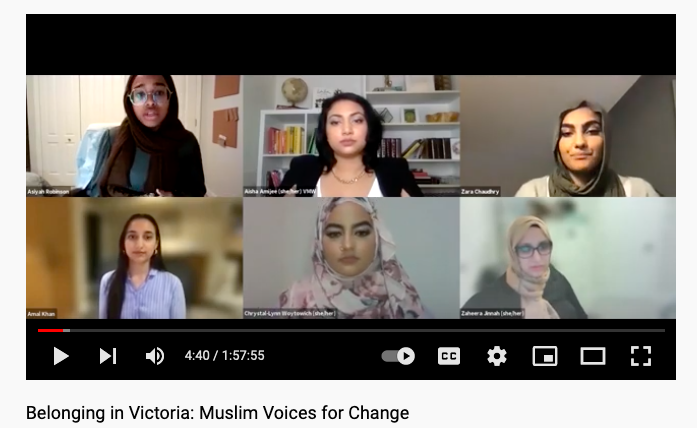
Economic Development and Prosperity

Victoria 3.0
Led the development of Victoria 3.0 Recovery, Reinvention, Resilience 2020-2041 a long-term plan to create inclusive, low-carbon prosperity. I had led the creation of the City’s previous economic action plan – Making Victoria: Unleashing Potential – after being elected in 2014. By 2019, the goals in that plan had been largely achieved and it was time for a new plan to get Victoria ready for the future. For Victoria 3.0, I started by pulling a small unofficial steering committee together that continued to drive the process throughout. Unlike Making Victoria which was locally focused, the development process for Victoria 3.0 began by us asking the question, “Who does Victoria want to be in an increasingly global world to make sure that we are well positioned?”
Drawing on the Brookings Institute’s 10 Traits of Globally Fluent Metro Areas, hosted topic and sector specific workshops in the fall of 2019 to learn from business leaders and entrepreneurs about their ambitions in the coming two decades. Incorporated their inputs, wrote the plan, and presented it back to the community for further input in January of 2020 at a public launch event.
Before Council could adopt the plan (revised based on community input) the pandemic hit. Our small group came back to the table to revise the plan accordingly, starting with supporting businesses through the pandemic and onto recovery while still maintaining the bold moves and big ambition. Council adopted Victoria 3.0 in May 2020.
In June 2020, Western Investor wrote:
“On May 30 the City of Victoria, and regional partners, released Victoria 3.0, an ambitious blueprint for sustained post-pandemic recovery. Its mandate reads: “Victoria is a future-ready, globally fluent influencer and innovator. We will use our status as a small powerhouse to create a strong and resilient economy that meets our needs now and anticipates the future … We are betting this is more than posturing: Victoria is for real and should be a leading light out of the pandemic darkness.”
TELUS Ocean
From identification of an opportunity in 2015 to ground-breaking in 2022, supported and helped to secure a significant investment by TELUS in downtown Victoria on a piece of surplus city-owned land. TELUS Ocean is envisioned as an iconic architectural landmark—a centre of activity, creativity and innovation in the heart of Victoria’s downtown and Inner Harbour. In addition to housing TELUS operations in Victoria, the building includes an innovation hub and community space. Keeping with Victoria’s Climate Leadership goals, it will be one of the most sustainable, zero carbon office buildings in Canada.


COAST
The Centre for Ocean Applied Sustainable Technologies, COAST, is a key deliverable of Victoria 3.0. Secured funding for business case. Assisted with public engagement and business case development. Helped develop mission and vision. Raised the profile of COAST with provincial and federal governments. Sat as an advisory board member to help secure start-up funding and move from planning to implementation. The vision is that COAST is Pacific Canada’s hub for the sustainable blue economy. COAST’s mission is to drive inclusive prosperity in British Columbia’s sustainable blue economy through entrepreneurship, innovation and expansive partnerships. Success means that by 2030, Pacific Canada will be known worldwide for leadership in the blue economy, with high-growth, globally-oriented companies that anticipate and solve problems, create high-value jobs and leave the ocean and planet in better condition than when we began.
Arts and Innovation District
In early 2019, convened a diverse group of community members and landowners to envision the future for underused employment lands adjacent to the Victoria harbour to the north end of downtown. These initial efforts rolled into a big move in Victoria 3.0 to develop an Arts and Innovation District. Supported staff in their pursuit of resources and funding to undertake a city-initiated rezoning of the area to create the conditions to realize the vision laid out in Victoria 3.0: a hub of cross-sector collaboration, a place where research and development lead to ideas that are commercialized, where new high-value, future-oriented jobs are created and where Victoria’s arts and culture sector can continue to flourish. Worked with the Songhees and Esquimalt Nations to lay initial groundwork for an economic revitalization program and tax exemption for the significant lands they recently acquired in the District.
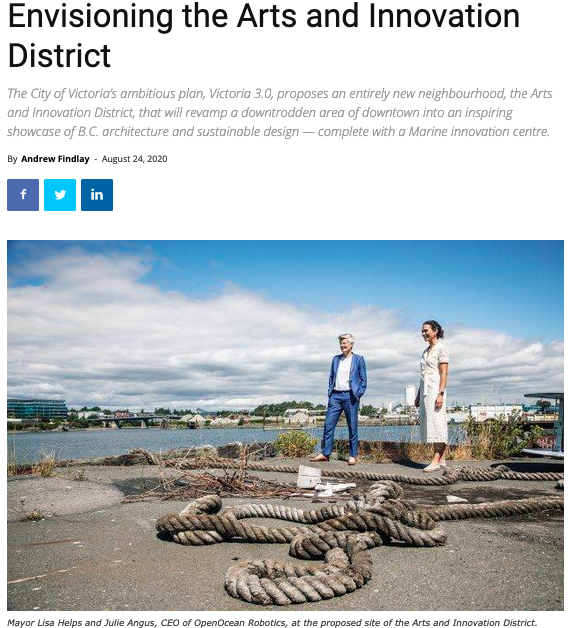
Infrastructure
Bike Network and Complete Streets
Championed the creation of a 32km all ages and abilities safe cycling network and the shift towards a “complete streets” approach to public realm improvements. Began implementation of the bike network on the busiest streets in the downtown core to increase safety in the most dangerous places first, then connected into neighbourhoods. At network completion (second quarter of 2023), all households in the city will be within 400m of the safe cycling network. Along with cycling infrastructure, added benches, crosswalks, significant traffic calming on neighbourhood streets, and new trees and native plant and pollinator species. In the early years of implementation there was significant and very vocal opposition to the bike lanes. Council had the political courage to keep building in the face of opposition. Six years later, there is acceptance of the network and a significant increase in bike ridership, particularly among seniors and young children.
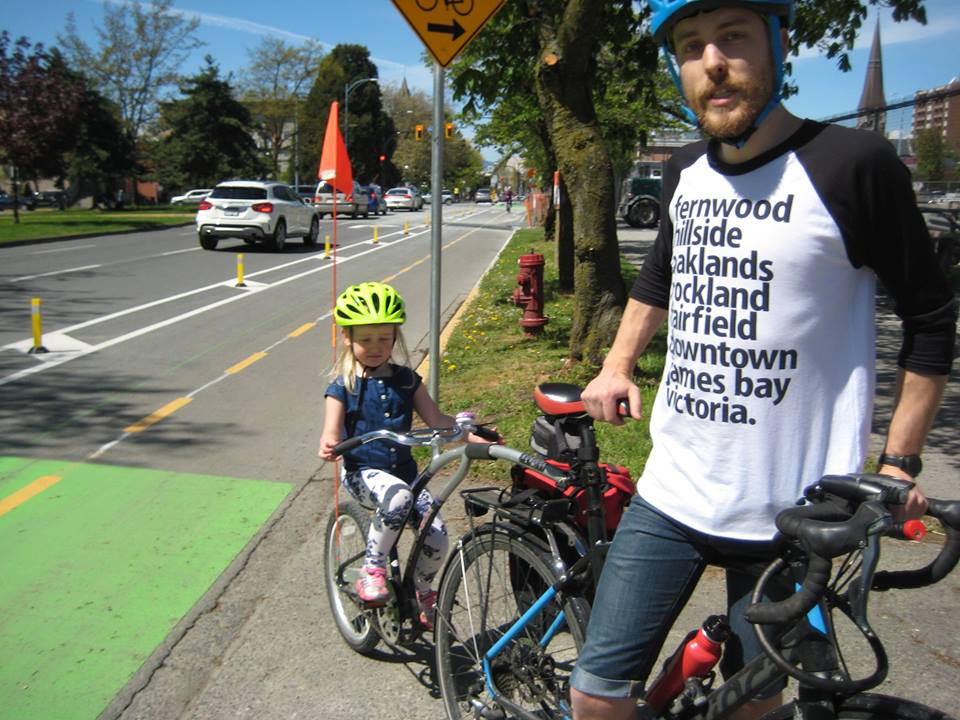

Sewage Treatment
After 30 years of debate and discussion, as chair of the Core Area Liquid Waste Management Committee at the Capital Regional District, worked with my colleagues, staff, the community, the provincial government, and officials in Washington State to break ground on a sewage treatment plant for our region. The $785 million project was completed on time and with just a slight budget increase due to material cost escalation. Worked with the provincial and federal governments to keep funding for the project in place despite years of delay. Helped with damage control through briefings of officials on both sides of the border as the non-treatment of Victoria sewage became a potential source of a tourism boycott from Washington State. After breaking ground on the project, led a delegation to Seattle to hold a retirement party for Mr. Floatie – who had become a local fixture advocating for sewage treatment – in partnership with the US Consul General in Vancouver and the Canadian Consul General in Seattle.
Firehall and Affordable Housing
After the City’s last major infrastructure project, the Johnson Street Bridge, came in years late, significantly over budget, and created a lack of trust that City Hall knew how to deliver big infrastructure projects, we knew we needed to take a different approach to the next big project, a new Firehall #1. Began by issuing a request for expressions of interest to the private sector to provide the city a new firehall. Narrowed options and locked in a fixed price contract with a local developer. Unlike the Johnson Street Bridge project where the “fixed price” contract was signed with the bridge only at 30% design, before signing the contract for the firehall, we fully scoped the project and had two independent quantity surveyors assess it. Worked with the local developer, BC Housing and a local non-profit to create a value added element of the project – 130 units of affordable housing above the firehall for families in the downtown.
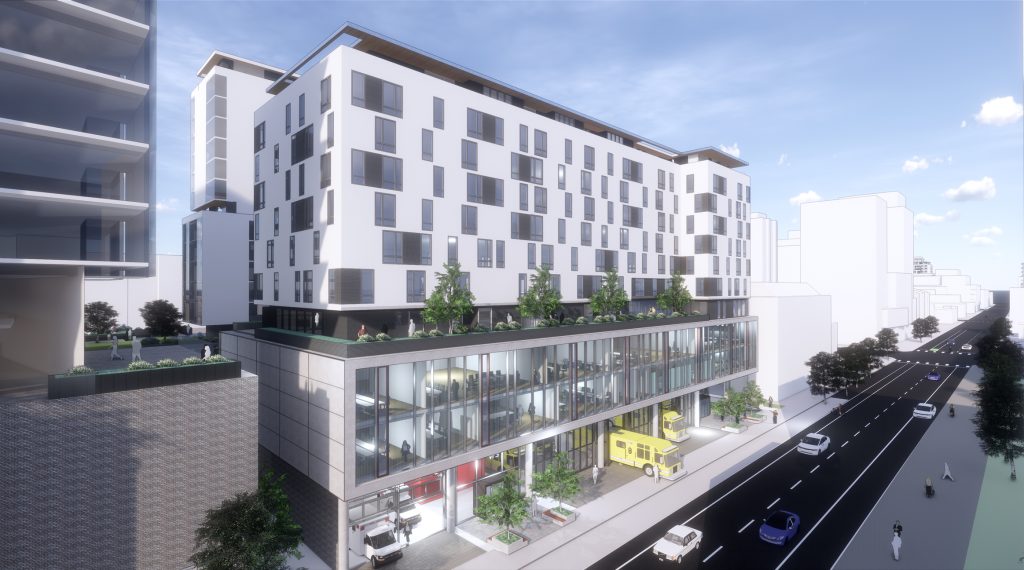
Vibrant Public Spaces
Car Free Day
Worked with the Downtown Victoria Business Association to create Car Free Day in downtown Victoria. Closed Douglas Street, a major downtown thoroughfare, to car traffic and opened it up to pedestrians, musicians and vendors. Each Car Free day drew tens of thousands of people from across Vancouver Island. The festival came to an end with COVID, but laid the groundwork for us all to experience and imagine different possibilities for city streets.
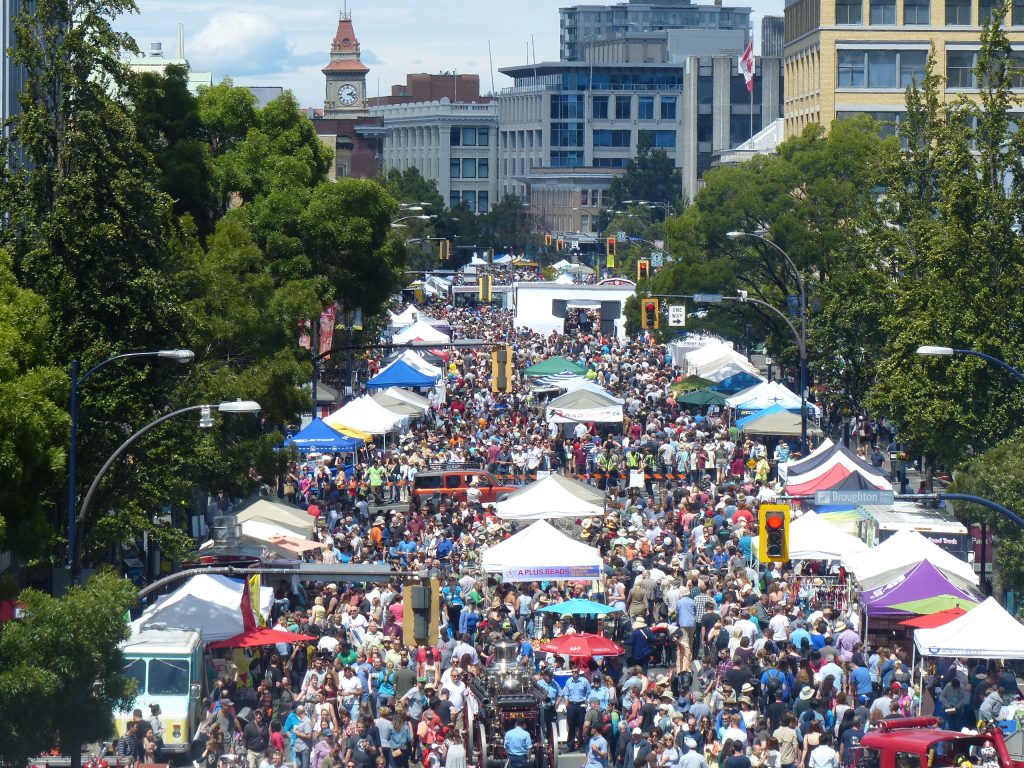

Pedestrian Priority Government Street
After decades of debate, COVID created an opportunity to pilot a pedestrian priority Government Street in downtown Victoria. Opened the streets to pedestrians only from noon to 10pm. Provided opportunities for pubs and restaurants to create patios. Installed street furniture and planters. Programmed the street with live music, supporting local artists through COVID. As the two-year pilot was underway, worked with the community, business owners and Songhees and Esquimalt Nations on a Government Street Refresh Project. Council adopted the recommendations of the Refresh project in the summer of 2022 making permanent the pedestrian priority approach to the street, creating two new public plazas, incorporating Indigenous culture and heritage into the street. This project will be implemented from 2022-2027 timed with underground infrastructure work that needs to be done to prepare the city for climate change.
Clover Point
Seizing an opportunity as the sewage treatment project was coming to a close, returned half of the space at Clover Point – along the Dallas Road waterfront – which had been reserved exclusively for cars for the last 60 years, to a pedestrian, cycling, and picnicking site. Installed additional accessible parking spaces to ensure the space and the view remained accessible to those who need to drive cars. Installed lounge chairs and accessible picnic tables. The intention is to pilot this new approach until a longer-term park planning process gets underway in 2023. The majority of Council had the political courage to stick with this decision despite the significant uproar and outcry from some members of the public.


Gorge Waterway Dock
Supported the efforts of the Victoria West community to install a large dock off Banfield Park, a much-loved community swimming hole in the Gorge Waterway. When the new dock opened in June 2022 the Gorge became even more of a vibrant community gathering space for people of all ages. The swimming area is adjacent to a pedestrian and cycling path, making it accessible for people without cars. Installed additional bike racks to meet demand soon after the dock opened.
Convening and Start-Ups
BC Urban Mayors’ Caucus
Helped to found the BC Urban Mayors’ Caucus (BCUMC), a group of 13 mayors from across urban British Columbia representing over 55 per cent of BC’s population. Co-chaired the caucus with Kelowna Mayor Colin Basran. Helped to draft a provincial and federal Blueprint for British Columbia’s Urban Future. Quickly established the BCUMC as a trusted partner and adviser to the provincial government on urban issues including affordable housing, mental health, substance use and treatment, public transit, and a new fiscal relationship with senior orders of government. Made significant progress in response to our call for complex care housing for those most vulnerable in our communities, including securing funding in the 2022 provincial budget. Initiated with the provincial government a rapid investigation into the impacts of repeat offenders in our communities; the BCUMC will continue to be involved as the recommendations are implemented. Provided input into upcoming provincial housing supply legislation. Met weekly Fridays at 7am to build relationships among the 13 of us and build momentum across the province.


BC Social Procurement Initiative
Helped establish the BC Social Procurement Initiative (initially the Coastal Communities Social Procurement Initiative) to change the culture of local government procurement in British Columbia. The purpose of BCSPI is to support local governments and institutions to implement social procurement best practices to build community well-being and resilience. Like many good things, initial discussions about the BCSPI began in a pub, following a presentation on social procurement at the Association of Vancouver Island and Coastal Communities (AVICC) conference in 2016.
Seizing on the enthusiasm of the large group of people who showed up for the discussion, myself and former Tofino Mayor Josie Osborne created and co-chaired an informal working group of our local government colleagues across the AVICC region. Secured initial funding to pilot the program on Vancouver Island and Coastal Communities for two years. Once inquires started to come from across the province, secured substantial additional funding to expand the program across British Columbia. Working with the local government steering committee and program delivery partners Scale Collaborative, helped to grow membership from an initial six local governments to close to 35 members today. In a 2021-2022 survey completed by 21 members, it was identified that at least $78 million in social procurement spend had been made by their communities in one year.
Vancouver Island and Coastal Communities Climate Leadership Plan
The Vancouver Island and Coastal Communities Climate Leadership Plan (VICC-CLP) process replicated the convening success noted above with BCSPI. At the AVICC conference in 2019, we gathered over 50 local elected officials as part of an off-program, informal workshop to discuss the impending threat of climate change to our local governments, communities, and First Nations in the AVICC region. Key areas of discussion included the lack of capacity for small and rural local governments and First Nations to mitigate and adapt to climate change, and the desire to learn from each other and share best practices. At the meeting, we posed the question: What would it be like – and what would it take – to create a climate mitigation and adaptation plan for our entire region?
With the great deal of excitement and inspiration generated by this question, myself along with former Tofino Mayor Josie Osborne, and Duncan Mayor Michelle Staples struck and co-chaired a working group with nominees appointed by each regional district board in the AVICC region.
Over a three-year period, we partnered with faculty and staff at the University of Victoria to undertake foundational research, and engaged local government elected officials and staff, youth across the region, and First Nations communities in the process of developing a 2030 Climate Leadership and Resilience plan for all of Vancouver Island and the Coastal Region. Secured funding along the way to undertake engagement with local governments, youth and First Nations. Just before the 2022 municipal election, engaged the Community Energy Association to act as secretariat for the VICC-CLP to ensure plan completion and presentation to the AVICC members in April 2023 and implementation of the plan out to 2030.
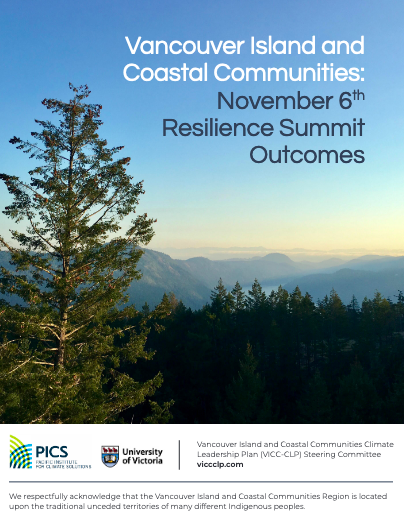

Mayor’s Community Drop In
When I was a city councillor, I got to sit in as acting mayor for one of the former mayor’s open-door sessions. There was a line-up of people in the waiting room. The mayor’s secretary would let them into the mayor’s office one at a time. At ten minutes, she would pop her head in the door, timer in hand and say that the time was up. That was the cue for the next person to file in. It struck me as odd that only the mayor would get to hear the ideas and concerns of the people who were dropping in; this seemed a missed opportunity for community building and dialogue.
When elected as mayor, I convened the Mayor’s Community Drop In, inviting the community into the office once every two weeks for coffee, tea and conversation. At the beginning of each session, I’d ask those in attendance what’s on the agenda today, and I’d write up the topics on a flip chart. We worked our way through the agenda with the person who put the topic up speaking first, but then everyone else in the room also weighing in. People got to hear different points of view, different issues of concern. The very best moments were when people connected and said to each other, “I can help you with that,” or “My neighbour had a similar issue,” or, best of all, “I’d never thought about it that way.” COVID-19 brought the Community Drop Ins to an end; we tried to do it online, but the feeling wasn’t the same.
Livable Cities Forum
Worked with the wonderful folks at ICLEI Canada, Local Governments for Sustainability, and city staff to convene the Liveable Cities Forum in Victoria in 2017, 2019, and 2022. The Liveable Cities Forum is a boutique national event widely known for its high-calibre practical sessions and diverse speakers on climate change action in Canada. It brings together government, community, and industry leaders to offer opportunities to learn, exchange ideas, and raise awareness on existing and emerging areas of practice related to climate change and communities. Working together with ICLEI, we curated an interactive peer learning space – through plenary sessions, workshops, and sessions on the move – for a diverse range of people to come together to explore how to build communities that are prepared for current and future impacts of climate change, while moving toward a more sustainable, healthy and equitable future.


COVID Response and Decampment Working Group
One of the times I felt most committed, connected and alive during my time as mayor was when the COVID-19 pandemic hit. As the world was shutting down around us, there was a team of us that continued to go into City Hall every day and we became the City’s core pandemic team. There was an intensity to the work that was very satisfying as we figured out how to adapt city services, what to keep open, what to close, and then the biggest dilemma – what to do for the 400 to 600 people who ended up homeless when shelters reduced their numbers, bubbles got smaller and people who had been staying with friends or family were literally sent outside.
Early on, I realized it was left to the City to bring everyone together to address pandemic-related homelessness. I called a meeting of everyone I thought could help and requested that we meet every day at 1pm. The meeting included BC Housing, Island Health, our Chief Medical Health Officer, and a few other core service agencies. I requested that the same person from each agency attend each day for continuity and also because building relationships would be key.
At each daily meeting I asked three questions: What did you do in the last 24 hours? What will you do in the next 24 hours? What support do you need to take action? It was a gigantic effort and took way too long, but eventually we had mobilized resources and – working with the provincial government – provided indoor sheltering opportunities to everyone who needed them.
None of this was perfect or smooth and there were lots of bumps and challenges along the way, but I liked the intensity of the work, the deep relationships that were built, and that there was a feeling of love in the (virtual) room as we did the work. The group became the Decampment Working Group. Meetings eventually went from daily, to weekly to biweekly, and we wrapped them up for good in August of 2021. People still talk about how they miss those meetings and that feeling of love, connection, and sense of purpose as we did our work together in a really difficult time.